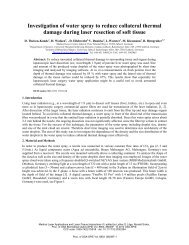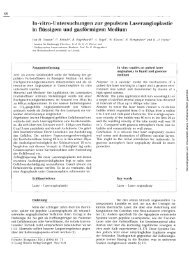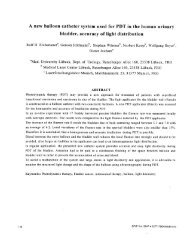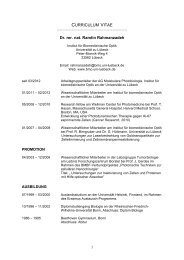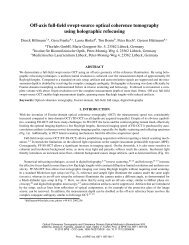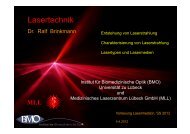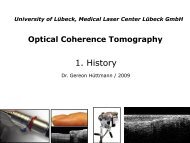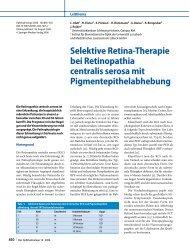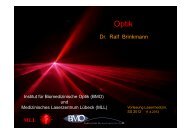Analysis of the signal fall-off in spectral domain optical coherence ...
Analysis of the signal fall-off in spectral domain optical coherence ...
Analysis of the signal fall-off in spectral domain optical coherence ...
You also want an ePaper? Increase the reach of your titles
YUMPU automatically turns print PDFs into web optimized ePapers that Google loves.
<strong>Analysis</strong> <strong>of</strong> <strong>the</strong> <strong>signal</strong> <strong>fall</strong>-<strong>of</strong>f <strong>in</strong> <strong>spectral</strong> doma<strong>in</strong> <strong>optical</strong><strong>coherence</strong> tomography systemsM. Hagen-Eggert 1,2 ,P.Koch 3 , G.Hüttmann 21 Medical Laser Center Lübeck, Germany2 Institute <strong>of</strong> Biomedical Optics Lübeck, Germany3 Thorlabs GmbHABSTRACTThe <strong>in</strong>fluence <strong>of</strong> <strong>the</strong> <strong>in</strong>dividual spectrometer components on <strong>the</strong> depth dependent sensitivity <strong>fall</strong>-<strong>of</strong>f (roll-<strong>of</strong>f)<strong>in</strong> <strong>spectral</strong>-doma<strong>in</strong> <strong>optical</strong> <strong>coherence</strong> tomography (SD-OCT) is <strong>in</strong>vestigated. We present a method for <strong>the</strong>characterization <strong>of</strong> <strong>the</strong> roll-<strong>of</strong>f <strong>in</strong> SD-OCT systems via modulation transfer function (MTF) analysis. The MTF <strong>of</strong>different image sensors was measured <strong>in</strong> a newly developed setup, which uses <strong>the</strong> <strong>in</strong>terference <strong>of</strong> two coherent lightbeams. Different contributions, i.e. diffraction, aberrations and sampl<strong>in</strong>g effects, to <strong>the</strong> MTF <strong>of</strong> a spectrometer<strong>of</strong> commercially available SD-OCT systems is calculated and is compared with roll-<strong>of</strong>f measurements. Thedifference was below −2 dB at 90 % <strong>of</strong> <strong>the</strong> maximum measurement depth.Keywords: <strong>optical</strong> <strong>coherence</strong> tomography, modulation transfer function, image detector, roll-<strong>of</strong>f1. INTRODUCTIONIn spectrometer-based OCT systems <strong>the</strong> <strong>signal</strong> sensitivity depends on <strong>the</strong> measurement depth. 1 This depthdependentsensitivity <strong>fall</strong>-<strong>of</strong>f, called roll-<strong>of</strong>f, is <strong>in</strong>herent to every Fourier-doma<strong>in</strong> OCT system, but becomesobvious <strong>in</strong> spectrometer based <strong>spectral</strong>-doma<strong>in</strong> (SD) OCT. Hence, it has become an important quality measurefor <strong>the</strong> performance <strong>of</strong> SD-OCT systems. Figure 1 schematically shows <strong>the</strong> setup <strong>of</strong> a typical spectrometer-basedOCT system.Figure 1: Schematic diagram <strong>of</strong> a typical SD-OCT system, consist<strong>in</strong>g <strong>of</strong> a fiber-based Michelson <strong>in</strong>terferometer withreference and sample arm, a broadband light source (SLD) and a spectrometer unit with: collimator (1), transmissiongrat<strong>in</strong>g (2), objective (3) and a l<strong>in</strong>e-scan detector(4)Optical path length delays <strong>in</strong> <strong>in</strong>terfer<strong>in</strong>g reference and radiation arm cause modulations <strong>in</strong> <strong>the</strong> <strong>signal</strong> spectra,which conta<strong>in</strong> <strong>the</strong> OCT <strong>in</strong>formation. In <strong>the</strong> spectrometer, <strong>the</strong> light is separated <strong>in</strong>to its <strong>spectral</strong> componentsFur<strong>the</strong>r author <strong>in</strong>formation: (Send correspondence to G.H.)M.H.: E-mail: hagen-eggert@bmo.uni-luebeck.de, Telephone: +49 (0) 451 500 6510P.K.: E-mail: pkoch@thorlabs.com, Telephone: +49 (0) 451 290 3370G.H. E-mail: huettmann@bmo.uni-luebeck.de, Telephone: +49 (0) 451 500 6530Optical Coherence Tomography and Coherence Doma<strong>in</strong> Optical Methods <strong>in</strong> Biomedic<strong>in</strong>e XVI,edited by Joseph A. Izatt, James G. Fujimoto, Valery V. Tuch<strong>in</strong>, Proc. <strong>of</strong> SPIE Vol. 8213, 82131K© 2012 SPIE · CCC code: 1605-7422/12/$18 · doi: 10.1117/12.910921Proc. <strong>of</strong> SPIE Vol. 8213 82131K-1Downloaded from SPIE Digital Library on 16 Apr 2012 to 91.20.237.54. Terms <strong>of</strong> Use: http://spiedl.org/terms
y <strong>the</strong> diffraction grat<strong>in</strong>g and afterwards, <strong>the</strong> spectrum is imaged on <strong>the</strong> l<strong>in</strong>e scan detector. The maximummeasurement depth <strong>of</strong> <strong>the</strong> OCT system depends on <strong>the</strong> highest spatial frequency that can be measured by <strong>the</strong>spectrometer. The SNR <strong>of</strong> an OCT system at a certa<strong>in</strong> depth z 1 , depends on <strong>the</strong> contrast transfer performance<strong>of</strong> <strong>the</strong> different spectrometer components at <strong>the</strong> correspond<strong>in</strong>g spatial frequency f 1 . So, <strong>the</strong> OCT roll-<strong>of</strong>f canbe described as a sensitivity loss due to <strong>the</strong> spatial frequency dependent transfer loss <strong>of</strong> <strong>signal</strong> contrast <strong>in</strong> <strong>the</strong>spectrometer unit. Hence, <strong>the</strong> roll-<strong>of</strong>f <strong>in</strong> SD-OCT systems is identical to <strong>the</strong> modulation transfer function (MTF)<strong>of</strong> <strong>the</strong> complete OCT system.The MTF is a well known measure for characteriz<strong>in</strong>g <strong>the</strong> imag<strong>in</strong>g performance <strong>of</strong> <strong>optical</strong> and electro-<strong>optical</strong>systems. It describes <strong>the</strong> response <strong>of</strong> <strong>optical</strong>- or electro-<strong>optical</strong> systems to s<strong>in</strong>usoids <strong>of</strong> various spatial frequencies. 2By tak<strong>in</strong>g advantage <strong>of</strong> <strong>the</strong> cascade properties <strong>of</strong> <strong>the</strong> MTF formalism we can separate <strong>the</strong> roll-<strong>of</strong>f <strong>in</strong>to MTFsallocated to s<strong>in</strong>gle spectrometer components. This is exemplarily shown <strong>in</strong> Fig. 2.Figure 2: Simplified schematic draw<strong>in</strong>g <strong>of</strong> <strong>the</strong> separation <strong>of</strong> <strong>the</strong> OCT roll-<strong>of</strong>f <strong>in</strong>to MTFs <strong>of</strong> <strong>the</strong> different spectrometercomponents.For <strong>the</strong> characterization <strong>of</strong> a SD-OCT systems roll-<strong>of</strong>f, <strong>the</strong> MTF <strong>of</strong> <strong>the</strong> image detector is <strong>of</strong> high importance.To measure it we used an experimental setup which projects s<strong>in</strong>usoidal <strong>in</strong>terference grat<strong>in</strong>gs with differentfrequencies on <strong>the</strong> image detectors under test. The results <strong>of</strong> <strong>the</strong> MTF measurements were comb<strong>in</strong>ed withcalculations <strong>of</strong> MTFs due to diffraction, aberration and sampl<strong>in</strong>g to calculate an overall roll-<strong>of</strong>f, which was <strong>the</strong>ncompared with roll-<strong>of</strong>f measurements <strong>of</strong> <strong>the</strong> correspond<strong>in</strong>g OCT device.The characterization <strong>of</strong> SD-OCT systems via MTF analysis gives a detailed <strong>in</strong>sight to <strong>the</strong> contribution <strong>of</strong> <strong>the</strong>spectrometer components to sensitivity degrad<strong>in</strong>g effects and shows possibilities for improvements <strong>in</strong> a SD-OCTsystems design. In this work <strong>the</strong> roll-<strong>of</strong>f <strong>of</strong> <strong>the</strong> commercially available THORLABS SD-OCT systems Callisto,Ganymede, Hyperion and Telesto is analyzed.2. THEORY2.1 MTF <strong>of</strong> image sensorsThe MTF <strong>in</strong> image detectors is fundamentally determ<strong>in</strong>ed by <strong>the</strong> detector footpr<strong>in</strong>t and sampl<strong>in</strong>g effects. 2 Theloss <strong>of</strong> <strong>signal</strong> contrast due to <strong>the</strong> detector footpr<strong>in</strong>t is based on <strong>the</strong> fact that <strong>the</strong> pixels are extended. Due to<strong>the</strong> rectangular shape <strong>of</strong> <strong>the</strong> detector pixels, <strong>the</strong> image detection performs spatial averag<strong>in</strong>g <strong>of</strong> <strong>the</strong> observedirradiation pattern, which results <strong>in</strong> a rect function as impulse response. Hence, <strong>the</strong> detector Footpr<strong>in</strong>t MTF <strong>of</strong>a l<strong>in</strong>e-scan detector with rectangular pixel aperture can be described as MTF F ootpr<strong>in</strong>t = s<strong>in</strong>c(ξ,w), where ξ is<strong>the</strong> spatial frequency and w <strong>the</strong> pixel pitch. 2Fur<strong>the</strong>rmore, it has to be considered that <strong>the</strong> position <strong>of</strong> <strong>the</strong> image irradiation pattern, with respect to <strong>the</strong> pixelpositions on <strong>the</strong> detector, affects <strong>the</strong> detected <strong>signal</strong> contrast. This effect is considered by <strong>the</strong> Sampl<strong>in</strong>g MTFwhich represents <strong>the</strong> average value <strong>of</strong> <strong>the</strong> possible MTFs that results from <strong>the</strong> variation <strong>of</strong> <strong>the</strong> irradiation patternwith respect to <strong>the</strong> pixel positions. For l<strong>in</strong>e-scan detectors with rectangular pixel aperture and a fill factor <strong>of</strong>one, <strong>the</strong> sampl<strong>in</strong>g MTF results as MTF Sampl<strong>in</strong>g = s<strong>in</strong>c(ξ,w). 2, 3In summary, <strong>the</strong> fundamental Detector MTF that can be described as:MTF Detector = s<strong>in</strong>c 2 (ξw) (1)The Nyquist frequency <strong>of</strong> <strong>the</strong> above-described l<strong>in</strong>e scan detector is set by f Nyq = 12w. Accord<strong>in</strong>gtoeq. 1<strong>the</strong><strong>the</strong>oretical sensitivity loss <strong>of</strong> <strong>the</strong> described detector at Nyquist frequency is about ≈−7.8 dB.Proc. <strong>of</strong> SPIE Vol. 8213 82131K-2Downloaded from SPIE Digital Library on 16 Apr 2012 to 91.20.237.54. Terms <strong>of</strong> Use: http://spiedl.org/terms
2.2 MTF <strong>of</strong> <strong>the</strong> spectrometer unitThe imag<strong>in</strong>g performance <strong>of</strong> an OCT systems spectrometer unit is basically limited by diffraction and aberrations.The diffraction limit <strong>of</strong> <strong>the</strong> spectrometer optics is proportional to F/# and <strong>the</strong> wavelength λ. Fur<strong>the</strong>rmore, <strong>the</strong>MTF <strong>of</strong> a spectrometer system is a function <strong>of</strong> λ, because every wavelength enters <strong>the</strong> objective lens under acerta<strong>in</strong> angle. Here, <strong>the</strong> MTF’s <strong>of</strong> <strong>the</strong> spectrometer units were modeled with ZEMAX for one wavelength <strong>in</strong> <strong>the</strong>center <strong>of</strong> <strong>the</strong> <strong>signal</strong> spectrum.For <strong>in</strong>stance, figure 3 schematically shows three spectrometer designs represent<strong>in</strong>g different states <strong>of</strong> development<strong>of</strong> <strong>the</strong> THORLABS Callisto OCT. Additionally, <strong>the</strong> plot <strong>in</strong> figure 4 shows <strong>the</strong> calculated sensitivity loss due todiffraction and aberrations at <strong>the</strong> Nyquist frequency <strong>of</strong> <strong>the</strong> detector.It is clear, that with grow<strong>in</strong>g grat<strong>in</strong>g efficiency and complexity <strong>of</strong> <strong>the</strong> optics, <strong>the</strong> impact <strong>of</strong> aberrations can bem<strong>in</strong>imized. Hence, <strong>in</strong> <strong>the</strong> spectrometer design process one always has to f<strong>in</strong>d a trade <strong>of</strong>f between technical effortand acceptable sensitivity loss.(a) (b) (c)Figure 3: Schematic draw<strong>in</strong>gs <strong>of</strong> spectrometer unit designs <strong>of</strong> <strong>the</strong> THORLABS Callisto SD-OCT for <strong>the</strong> versions <strong>of</strong> 2007(a), 2009 (b) and <strong>the</strong> current version (2011) (c)Figure 4: Calculated sensitivity loss at Nyquist frequency due to diffraction (gray) and aberrations (black) for <strong>the</strong> 2007,<strong>the</strong> 2009 and <strong>the</strong> 2011 version <strong>of</strong> <strong>the</strong> THORLABS Callisto spectrometer unit.Proc. <strong>of</strong> SPIE Vol. 8213 82131K-3Downloaded from SPIE Digital Library on 16 Apr 2012 to 91.20.237.54. Terms <strong>of</strong> Use: http://spiedl.org/terms
3. EXPERIMENTAL SET-UP FOR MTF MEASUREMENT OF IMAGE SENSORS3.1 Design and operationThe measurement <strong>of</strong> <strong>the</strong> MTF <strong>of</strong> l<strong>in</strong>e-scan detectors was based on <strong>the</strong> work <strong>of</strong> Marchywka et al. 4Figure 5: Schematic diagram <strong>of</strong> <strong>the</strong> setup with <strong>the</strong> components: OI: <strong>optical</strong> isolator, MS1/MS2: MEMS switches, FPC:fiber-based polarization controllers, PBS: polariz<strong>in</strong>g beam splitter, C: cyl<strong>in</strong>drical lens, DAQ: data acquisition card, DUT:device under test, PC: Computer for data evaluationThe cameras under test were illum<strong>in</strong>ated by two coherent beams which were derived from a s<strong>in</strong>gle-modelaser diode source (Laser Diode: THORLABS LPS-830-FC; Controll<strong>in</strong>g unit: THORLABS ITC502). At <strong>the</strong>illum<strong>in</strong>ation output two FC-PC ferrules were aligned <strong>in</strong> parallel to each o<strong>the</strong>r <strong>in</strong> a well known distance <strong>of</strong> 3,5mm. Both fibers emitted divergent light cones which <strong>in</strong>terfered with each o<strong>the</strong>r, so that a s<strong>in</strong>usoidal <strong>in</strong>terferencepattern occurred on <strong>the</strong> detector which was placed <strong>in</strong> <strong>the</strong> beams. The spatial frequency <strong>of</strong> <strong>the</strong> <strong>in</strong>terferencepattern depends on <strong>the</strong> distance <strong>of</strong> <strong>the</strong> camera to <strong>the</strong> open fiber ends (see distance x <strong>in</strong> Fig. 5).From <strong>the</strong> measured fr<strong>in</strong>ge patterns <strong>the</strong> modulation contrast was calculated byM(n) = I(n) − (I 1(n)+I 2 (n))2 · √I1 (n) · I 2 (n)(2)Here I 1 (n) andI 2 (n) are <strong>the</strong> irradiances <strong>of</strong> each illum<strong>in</strong>ation arm on <strong>the</strong> sensor. After <strong>the</strong> acquisition <strong>of</strong> <strong>the</strong><strong>in</strong>terference <strong>signal</strong> I(n) and its components I 1 (n) andI 2 (n), a black image is subtracted from <strong>the</strong> o<strong>the</strong>r imagedata. The <strong>signal</strong> contrast was detected by calculat<strong>in</strong>g <strong>the</strong> power spectrum <strong>of</strong> M(n) via Fourier transform. Fromanalyz<strong>in</strong>g <strong>the</strong> power spectrum we determ<strong>in</strong>ed <strong>the</strong> modulation frequency f S and <strong>the</strong> contrast <strong>of</strong> <strong>the</strong> <strong>signal</strong>.4. RESULTS4.1 MTF <strong>of</strong> image detectorsThe specifications <strong>of</strong> <strong>the</strong> l<strong>in</strong>e-scan cameras and -sensors that were measured are listed <strong>in</strong> table 1. Figure 6 shows<strong>the</strong> MTF’s <strong>of</strong> <strong>the</strong> l<strong>in</strong>e-scan detectors <strong>in</strong> dB aga<strong>in</strong>st <strong>the</strong> spatial frequency normalized to <strong>the</strong> Nyquist frequency <strong>of</strong><strong>the</strong> image detectors. Additionally, <strong>the</strong> <strong>the</strong>oretical MTF <strong>of</strong> an ideal detector accord<strong>in</strong>gtoEq.1isshown.The LIS1024 CMOS sensor, <strong>the</strong> BALSER Runner and BASLER Spr<strong>in</strong>t follow <strong>the</strong> <strong>the</strong>oretical expectations andhave a maximum loss <strong>of</strong> <strong>signal</strong> contrast at Nyquist frequency vary<strong>in</strong>g from ≈−9 dB (LIS1024 CMOS sensor) to≈−10, 5 dB (BASLER Runner and Spr<strong>in</strong>t). The maximum sensitivity loss <strong>of</strong> <strong>the</strong> GOODRICH SU-LDH camerawas measured to be less than −6 dB, which is less than <strong>the</strong>oretically expected. Possible explanations can be adetector fill factor <strong>of</strong> less than one or a non-uniform spatial sensitivity <strong>of</strong> each pixel. 2Proc. <strong>of</strong> SPIE Vol. 8213 82131K-4Downloaded from SPIE Digital Library on 16 Apr 2012 to 91.20.237.54. Terms <strong>of</strong> Use: http://spiedl.org/terms
Figure 7: OCT roll-<strong>of</strong>f simulation consist<strong>in</strong>g <strong>of</strong> <strong>the</strong> measured detector MTF- and calculated spectrometer MTF plots.maximum sensitivity loss <strong>of</strong> −9.25 dB here<strong>of</strong> −6.25 dB can be allocated to detector footpr<strong>in</strong>t and sampl<strong>in</strong>g. Thediscrepancy between <strong>the</strong> calculated overall MTF and <strong>the</strong> roll-<strong>of</strong>f measurement (Figure 7: O<strong>the</strong>r losses) islessthan −2 dB. This shows that <strong>the</strong> roll-<strong>of</strong>f performance <strong>of</strong> <strong>the</strong> Ganymede OCTsystemislessthan6dBfrom<strong>the</strong>fundamental limit <strong>of</strong> sampl<strong>in</strong>g and footpr<strong>in</strong>t MTF.The OCT roll-<strong>of</strong>f values are most significant at <strong>the</strong> maximum measurement depth. Therefore, only <strong>the</strong> resultsat 90% <strong>of</strong> <strong>the</strong> measurement depth <strong>of</strong> <strong>the</strong> o<strong>the</strong>r THORLABS SD-OCT systems are presented. Figure 8a shows <strong>the</strong>roll-<strong>of</strong>f analysis <strong>of</strong> <strong>the</strong> current versions <strong>of</strong> <strong>the</strong> THORLABS Callisto, Ganymede and Hyperion. The plots display<strong>the</strong> sensitivity losses at 90% <strong>of</strong> <strong>the</strong> measurement range due to diffraction, aberrations, detector footpr<strong>in</strong>t/sampl<strong>in</strong>gand additional detector losses. The lower end <strong>of</strong> each bar marks <strong>the</strong> measured OCT roll-<strong>of</strong>f. The gab between<strong>the</strong> roll-<strong>of</strong>f simulation and <strong>the</strong> roll-<strong>of</strong>f measurement is <strong>in</strong>dicated as o<strong>the</strong>r losses.The roll-<strong>of</strong>f analysis shows that Callisto, Ganymede and Hyperion have a quite similar roll-<strong>of</strong>f behavior. Forall three systems <strong>the</strong> impact <strong>of</strong> diffraction is less that −2 dB whereas aberrations are negligible. Sensitivitylosses due to <strong>the</strong> detector are <strong>the</strong> ma<strong>in</strong> component <strong>in</strong> <strong>the</strong> OCT roll-<strong>of</strong>f and go from −8.2 dB (Calliso) to −9.8 dB(Hyperion). The roll-<strong>of</strong>f was measured to be −10.8 dB for <strong>the</strong> Callisto, −12.1 dB for <strong>the</strong> Ganymede and −12.9 dBfor <strong>the</strong> Hyperion. For all three OCT devices, <strong>the</strong> discrepancy between <strong>the</strong> roll-<strong>of</strong>f measurement and <strong>the</strong> simulationlies with<strong>in</strong> a range <strong>of</strong> up to −2 dB.The OCT roll-<strong>of</strong>f analysis <strong>of</strong> <strong>the</strong> Telesto is plotted <strong>in</strong> figure 8b. Here,<strong>the</strong> impact <strong>of</strong> Detector footpr<strong>in</strong>t andsampl<strong>in</strong>g on <strong>the</strong> sensitivity <strong>fall</strong>-<strong>of</strong>f could not be calculated, because <strong>the</strong> exact values <strong>of</strong> <strong>the</strong> camera specifications(Goodrich SU-LDH) is still unknown at <strong>the</strong> time. However, <strong>the</strong> <strong>in</strong>fluence <strong>of</strong> diffraction was calculatedto be ≈−0, 42 dB and aberrations are negligible as well. The sensitivity loss <strong>of</strong> <strong>the</strong> detector was measuredto be −5.2 dB, whereas <strong>the</strong> roll-<strong>of</strong>f <strong>of</strong> <strong>the</strong> correspond<strong>in</strong>g OCT system is −6 dB. The discrepancy between <strong>the</strong>simulation and <strong>the</strong> roll-<strong>of</strong>f measurement is −0.36 dB, which <strong>in</strong>dicates that <strong>the</strong> Telesto OCT is almost at <strong>the</strong>fundamental limit.The o<strong>the</strong>r losses represent all <strong>signal</strong> degrad<strong>in</strong>g effects which were not considered <strong>in</strong> this analysis. PossibleProc. <strong>of</strong> SPIE Vol. 8213 82131K-6Downloaded from SPIE Digital Library on 16 Apr 2012 to 91.20.237.54. Terms <strong>of</strong> Use: http://spiedl.org/terms
(a)(b)Figure 8: Roll-<strong>of</strong>f analysis <strong>of</strong> <strong>the</strong> THORLABS SD-OCT systems. Sensitivity loss <strong>in</strong> dB at 90 % <strong>of</strong> <strong>the</strong> measurement range<strong>of</strong> <strong>the</strong> Callisto (detector: PVS LIS1024), Ganymede (detector: BASLER Runner), Hyperion (detector: BASLER Spr<strong>in</strong>t)(a) and <strong>the</strong> Telesto OCT (detector: GOODRICH SU-LDH)(b)reasons could be additional aberrations <strong>of</strong> <strong>the</strong> grat<strong>in</strong>g, tolerances <strong>of</strong> <strong>the</strong> <strong>optical</strong> components and <strong>the</strong> alignment.In <strong>the</strong> roll-<strong>of</strong>f simulation <strong>the</strong> MTF due to aberrations is calculated for a s<strong>in</strong>gle wavelength <strong>in</strong> <strong>the</strong> center <strong>of</strong> <strong>the</strong>spectra. This leads to a discrepancy because aberrations are not constant over <strong>the</strong> field <strong>of</strong> view <strong>of</strong> <strong>the</strong> spectrometeroptics. The <strong>in</strong>fluence <strong>of</strong> aberrations rises at <strong>the</strong> edge <strong>of</strong> <strong>the</strong> detector, but lies typically below −5 dB. But, dueto <strong>the</strong> limited bandwidth <strong>of</strong> <strong>the</strong> light source, <strong>the</strong> <strong>in</strong>fluence <strong>of</strong> aberrations at <strong>the</strong> edges <strong>of</strong> <strong>the</strong> l<strong>in</strong>e detector on <strong>the</strong>OCT roll-<strong>of</strong>f is small.In order to estimate <strong>the</strong> <strong>in</strong>fluence <strong>of</strong> manufactur<strong>in</strong>g tolerances on <strong>the</strong> OCT systems performance, <strong>the</strong> roll-<strong>of</strong>fcharacteristics <strong>of</strong> 11 different Callisto OCT devices were measured. The average roll-<strong>of</strong>f value was ≈−10.8 dBat 90 % <strong>of</strong> <strong>the</strong> measurement range and <strong>the</strong> calculation <strong>of</strong> <strong>the</strong> standard deviation returned σ ≈ 1, 3 dB. Thisshows that <strong>the</strong> variations due to manufactur<strong>in</strong>g tolerances lie with<strong>in</strong> <strong>the</strong> range <strong>of</strong> <strong>the</strong> discrepancy <strong>in</strong> <strong>the</strong> roll-<strong>of</strong>fanalysis. In this case <strong>the</strong> variations are even slightly higher than <strong>the</strong> o<strong>the</strong>r losses. This could be due to variations<strong>in</strong> <strong>the</strong> performance <strong>of</strong> <strong>the</strong> correspond<strong>in</strong>g image detectors or to observational errors.5. SUMMARYAn MTF analysis <strong>of</strong> <strong>the</strong> roll-<strong>of</strong>f performance <strong>of</strong> SD-OCT systems was presented and compared with roll-<strong>of</strong>fmeasurements. It was shown that <strong>the</strong> detector MTF is <strong>the</strong> ma<strong>in</strong> component <strong>in</strong> a SD-OCT systems roll-<strong>of</strong>f.The MTF analysis provides a more detailed <strong>in</strong>sight <strong>in</strong>to <strong>the</strong> contribution <strong>of</strong> spectrometer components to <strong>the</strong>depth-dependent sensitivity <strong>fall</strong>-<strong>of</strong>f <strong>of</strong> SD-OCT systems. Hence, <strong>the</strong> MTF analysis <strong>of</strong>fers <strong>the</strong> opportunity to f<strong>in</strong>da well balanced trade-<strong>of</strong>f between desired OCT performance and technical effort.REFERENCES[1] Drexler, W., [Optical <strong>coherence</strong> tomography: technology and applications], Spr<strong>in</strong>ger Verlag (2008).[2] Boreman, G., [Modulation transfer function <strong>in</strong> <strong>optical</strong> and electro-<strong>optical</strong> systems], SPIE Press, Bell<strong>in</strong>gham,WA (2001).[3] Park, S., Schowengerdt, R., and Kaczynski, M., “Modulation-transfer-function analysis for sampled imagesystems,” Applied optics 23(15), 2572–2582 (1984).[4] Marchywka, M. and Socker, D., “Modulation transfer function measurement technique for small-pixel detectors,”Applied optics 31(34), 7198–7213 (1992).Proc. <strong>of</strong> SPIE Vol. 8213 82131K-7Downloaded from SPIE Digital Library on 16 Apr 2012 to 91.20.237.54. Terms <strong>of</strong> Use: http://spiedl.org/terms



